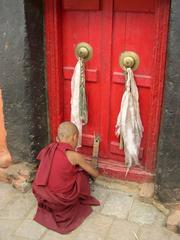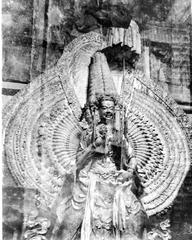Leh Palace Visiting Hours, Tickets, and Travel Guide
Date: 14/06/2025
Introduction
Leh Palace, a majestic nine-story monument perched atop Namgyal Hill in Leh, Ladakh, India, stands as a powerful symbol of the region’s royal heritage and architectural ingenuity. Constructed in the 17th century by King Sengge Namgyal, this imposing palace not only dominates the Leh skyline but also offers visitors a window into Ladakh’s dynastic history, Buddhist culture, and traditional Tibeto-Himalayan architecture (Cliffhangers India; Charzan Holidays). With panoramic views of the Himalayas and the Indus Valley, Leh Palace is a must-visit for history lovers, architecture enthusiasts, and travelers seeking an immersive cultural experience.
This comprehensive guide provides detailed information on the palace’s history, architectural highlights, visiting hours, ticketing, travel tips, accessibility, nearby attractions, and frequently asked questions.
Historical Overview
Origins and Construction
Leh Palace, known locally as Lhachen Palkhar, began its construction in 1553 under King Tsewang Namgyal and was completed in the early 17th century by his successor, King Sengge Namgyal (Cliffhangers India; Enroute Indian History). Its strategic location atop Tsemo Hill was chosen for defense and for its resemblance to an elephant’s head, according to legend. The palace, once the tallest building in the Himalayas, features nine levels that housed the royal family, ceremonial halls, temples, and stables.
Architectural Significance
Inspired by the Potala Palace in Lhasa, Tibet, Leh Palace displays traditional Tibeto-Himalayan architecture with thick, sloping stone and mud walls, flat roofs, and minimal ornamentation (Leh Ladakh India). Local materials, such as mud bricks, stone, and timber, provide natural insulation against Ladakh’s harsh climate. The palace’s upper floors contained royal apartments and prayer rooms adorned with Buddhist murals, while the lower levels included storage and staff quarters (Enroute Indian History). Notable features include intricately carved wooden balconies, the Lion Gate entrance, and a central courtyard that served as the heart of royal and cultural gatherings.
Historical Events and Restoration
During its zenith, Leh Palace was the political and cultural center of Ladakh, reflecting the prosperity of the Namgyal dynasty and its role in Silk Road trade (Leh Ladakh Taxis). The Dogra invasion in 1834 led to the palace’s abandonment, as the royal family relocated to Stok Palace. Restoration efforts by the Archaeological Survey of India (ASI) began in the late 20th century, and conservation continues today, preserving the palace as a Monument of National Importance (Enroute Indian History).
Visiting Leh Palace: Practical Information
Visiting Hours
- Standard Hours: 9:00 AM to 5:00 or 6:00 PM daily (small seasonal variations may apply).
- Best Time to Visit: April to September, when the weather is pleasant and skies are clear (Cliffhangers India; Thrillophilia).
Ticket Prices
- Indian Nationals: ₹50 (some sources report ₹15–₹25)
- Foreign Nationals: ₹200 (some sources report ₹100–₹300)
- Children under 15: Free
- Tickets: Available at the palace entrance (Vargis Khan; Tourism of India)
How to Get There
- Location: 1.5 km from Leh town center, perched atop Namgyal Hill (Leh Ladakh India)
- On Foot: 10–20 minutes uphill walk from Leh Market
- By Taxi/Auto: Readily available and convenient
- By Public Bus: No direct bus; nearby stops in Leh town (Go2Ladakh)
- By Bike/Scooter: Popular for independent travelers
Accessibility
Leh Palace is not wheelchair accessible. The approach involves steep, uneven paths and stairs. Visitors should wear sturdy shoes and be prepared for the elevation (approx. 11,700 feet/3,566 meters).
Guided Tours and Photography
- Guided Tours: Available on-site and via local agencies; recommended for historical and cultural context.
- Photography: Allowed in most areas except inside the museum. The rooftop and terraces provide excellent panoramic views, especially in the early morning or late afternoon (Vargis Khan).
Visitor Tips
- Acclimatize: Spend at least a day in Leh before visiting to adapt to the altitude.
- Hydrate: Carry water; the dry climate can cause dehydration.
- Dress Appropriately: Layered clothing and sun protection are essential.
- Plan Ahead: Avoid peak afternoon crowds and check for any special events or closures.
- Respect the Site: Do not touch artifacts or murals; follow staff instructions.
Nearby Attractions
- Namgyal Tsemo Monastery: Just above the palace, offering ancient manuscripts and panoramic views (Ratna Voyages).
- Shanti Stupa: A short drive away, ideal for sunrise or sunset vistas (Cliffhangers India).
- Leh Old Town & Market: Explore traditional Ladakhi architecture, local crafts, and cuisine.
- Other Monasteries: Thiksey, Hemis, and Spituk are within driving distance.
Cultural Significance and Events
Leh Palace hosts local festivals such as Dosmoche and Losar, featuring traditional dances and ceremonies in its courtyard. The palace’s prayer rooms and Buddhist artifacts reflect its ongoing role in Ladakh’s spiritual and cultural life (Enroute Indian History; Charzan Holidays). Restoration initiatives and community activities continue to reinforce its status as a living cultural hub.
Frequently Asked Questions (FAQs)
Q: What are the Leh Palace visiting hours?
A: Usually 9:00 AM to 5:00 or 6:00 PM, with minor seasonal variations.
Q: How much are Leh Palace tickets?
A: ₹50 for Indian citizens, ₹200 for foreign nationals (prices may vary); children under 15 typically enter free.
Q: Is Leh Palace wheelchair accessible?
A: No; the path is steep and involves stairs.
Q: Are guided tours available?
A: Yes, both on-site and through local agencies.
Q: Can I take photographs inside Leh Palace?
A: Yes, except in the museum.
Q: What is the best time to visit Leh Palace?
A: April to September, for pleasant weather and clear views.
Safety and Responsible Tourism
- Altitude: Monitor for symptoms of altitude sickness.
- Environment: Do not litter and respect the fragile ecosystem.
- Cultural Respect: Dress modestly and observe local customs.
Summary and Visitor Recommendations
Leh Palace is more than an architectural marvel; it is a living record of Ladakh’s royal, spiritual, and cultural legacy. Its nine-story structure, adorned with ancient murals and artifacts, offers visitors an opportunity to step back in time and experience Himalayan history firsthand. With accessible visiting hours, affordable ticketing, and proximity to other major attractions, Leh Palace is an essential stop in any Leh itinerary (Enroute Indian History; Charzan Holidays).
For the best experience, plan ahead, acclimatize to the altitude, consider a guided tour, and explore nearby landmarks like Namgyal Tsemo Monastery and Shanti Stupa. Don’t forget your camera to capture the sweeping Himalayan vistas from the palace rooftop.
Plan Your Visit
Download the Audiala app for in-depth guides, audio tours, and updates on Leh Palace and other Ladakh attractions. Stay connected by following our social media channels for cultural news, travel tips, and exclusive content.
Sources
- Cliffhangers India – Leh Palace
- Charzan Holidays – Leh Palace
- Leh Ladakh India – Leh Palace
- Vargis Khan – Leh Palace Guide
- Enroute Indian History – Leh Palace
- Thrillophilia – Royal Leh Palace

